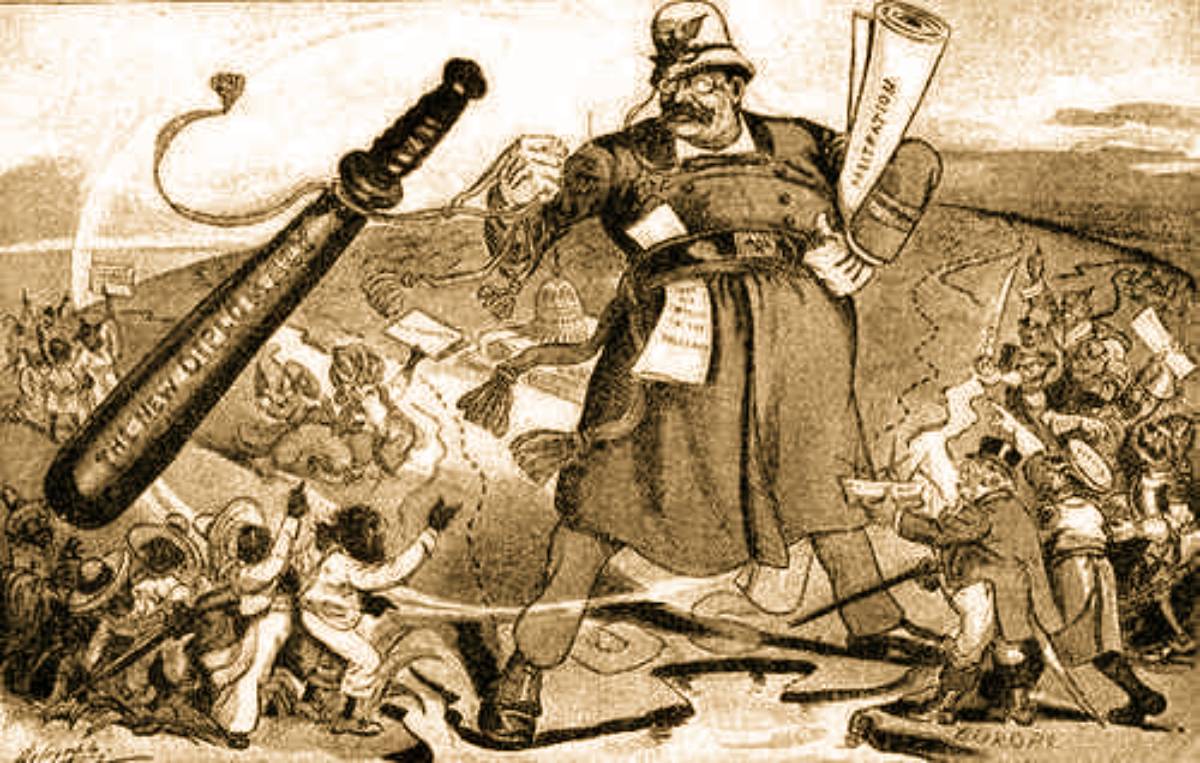The legacy of empire was particularly complex in South Africa, where there were two, not one, white settlement groups. Britain acquired the Cape Colony from the Netherlands in 1815. Because the Cape was strategically important and the climate seemed suited to European settlement, Britishers arrived and soon began to compete for land with the older European colonists, the Boers (Dutch for “farmer”).
The adoption of English as the sole official language, the abolition of slavery throughout the empire, and the attempts by London to protect the aboriginal population went against the grain of the patriarchal Boers, fundamentalist Christians who believed that the Bible told them that slavery was ordained of God. Between 1835 and 1837 some ten thousand Boers moved north into sparsely settled country in the Great Trek.
Needing more land to support their custom that each farmhouse should be an hour’s walk from any other house (making the average farm six thousand acres in size), and refusing to acknowledge any African rights to the land they were occupying, the Boers pressed against the Bantu and other groups. After some confused three-cornered fighting among Boers, British, and Zulus, the Boers established two virtually independent states—the Transvaal and the Orange Free State. The British settled another province to the east along the Indian Ocean, known as Natal. Cape Colony and Natal, which both had black populations heavily outnumbering the British and remaining Boer residents combined, acquired self-governing rights.
The British Empire at the southern end of the African continent grew slowly, caught up in contending policies between ambitious colonial politicians and imperial administrators on the one hand, and indigenous leaders on the other. In 1852, by the Sand River Convention, the British acknowledged the independence of the Transvaal; soon after they also acknowledged that of the Orange Free State.
But in 1877 they reversed themselves and annexed the Transvaal as a step toward the federation of all South Africa under the British Crown. The Boers revolted in 1880, and the Liberal Gladstone lived up to his principles by making a treaty with the Boers at Pretoria in 1881 that reestablished the Transvaal as independent, though under the “suzerainty” of Great Britain.
The British were already filtering up through the arid country to the west of the Boer republics when the discovery of gold and the development of a diamond industry in these republics undid Gladstone’s work. The Transvaal was no longer a poor and isolated grazing country; it offered a great source of wealth that tempted settlers of a quite different kind. The region about Johannesburg, the Rand, filled up with adventurers and entrepreneurs of a dozen nations, all looking to Britain to protect them from the conservative Boers, to whom they were undesirable Uitlanders (outlanders).
The simmering conflict came to a head with the Jameson Raid of December 29, 1895.* The British in South Africa were now under the leadership of Cecil Rhodes, the prime minister of Cape Colony and a determined imperialist who had made a quick fortune consolidating the chaotic diamond industry. The raid itself, under Dr. Leander Jameson (1853-1917), was an invasion of the Transvaal from British territory and was planned to coincide with an uprising of Uitlanders in Johannesburg.
But the uprising did not take place, and the president of the Transvaal, Paul Kruger (1825-1904), had no trouble defeating Jameson’s handful of invaders. Boer resistance to the Uitlanders hardened with alien expulsion and immigration restriction acts, and controls were placed over the right of assembly and freedom of the press. The two Boer republics renewed a defensive alliance and presented an ultimatum to the British government. The ultimatum was rejected, and the Boer War began on October 11, 1899.
The British did not have enough troops immediately available to put down determined Boer fighters, who were on their ow ground and were accustomed to the rigors of outdoor life. Western opinion generally sided with the underdog Boers, and even in Britain many Liberals and Labourites strongly opposed the war.
But in the long run the overwhelming strength of British numbers and technology prevailed. By the middle of 1900 the British had won in the field, but it took another eighteen months to subdue the desperate guerrilla bands. In 1902, by the Treaty of Vereeniging, the Boers accepted British rule, with the promise of ultimate self-government. In 1910 the British created the Union of South Africa, linking Cape Colony, the Transvaal, the Orange Free State, and Natal.
Thus, on the eve of World War I South Africa was among the self-governing British dominions. Briton and Boer seemed to be ready to collaborate in developing an increasingly important outpost of the West. But there were ominous signs even then. The Boers resisted being Anglicized, and the foundations of an intensely divisive policy of racial segregation had been laid.
Since racial barriers were applied to freedom of movement, the very notion of a “frontier” of opportunity failed to arise, and South Africa created for itself a major problem relating to migrant labor. The two European elements together were in a minority of one to four compared with the non-Europeans: the Africans, the East Indians (who had immigrated in great numbers, especially to Natal), and the “coloured” peoples of mixed blood.

